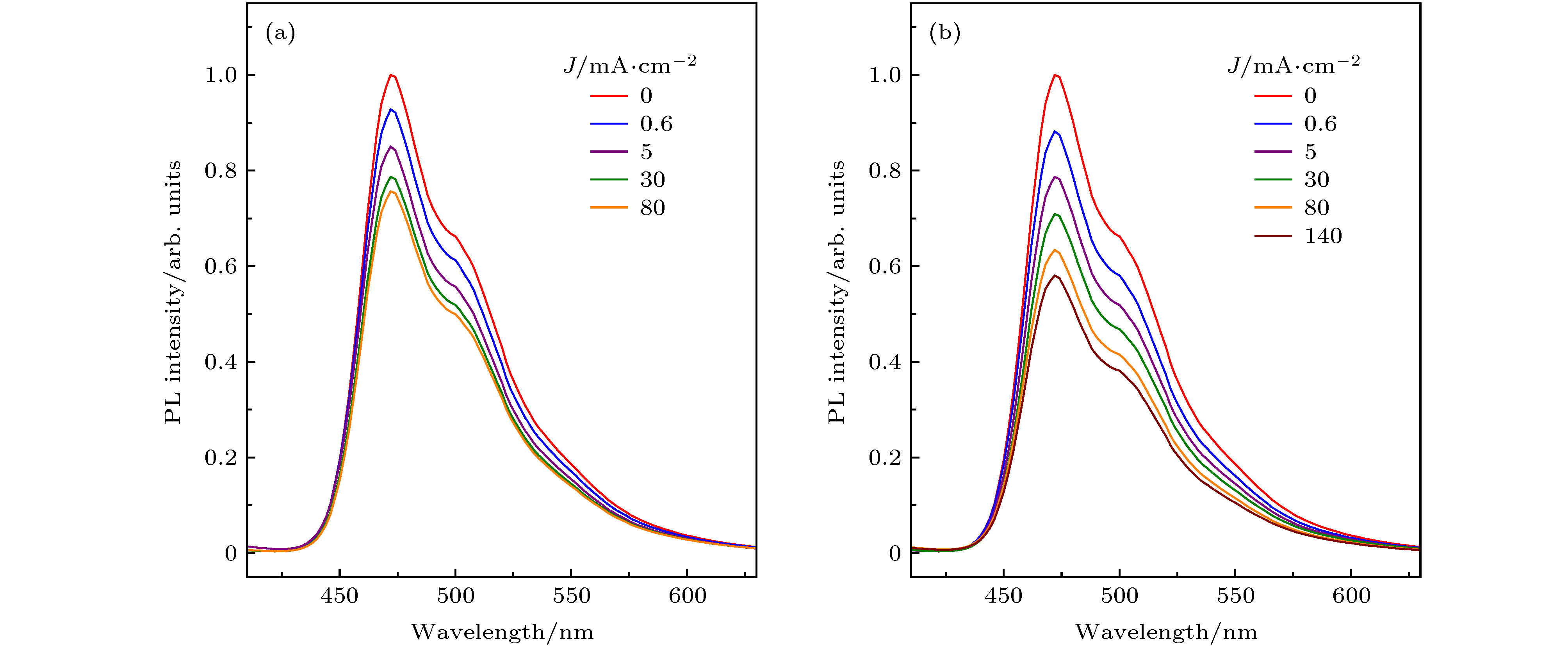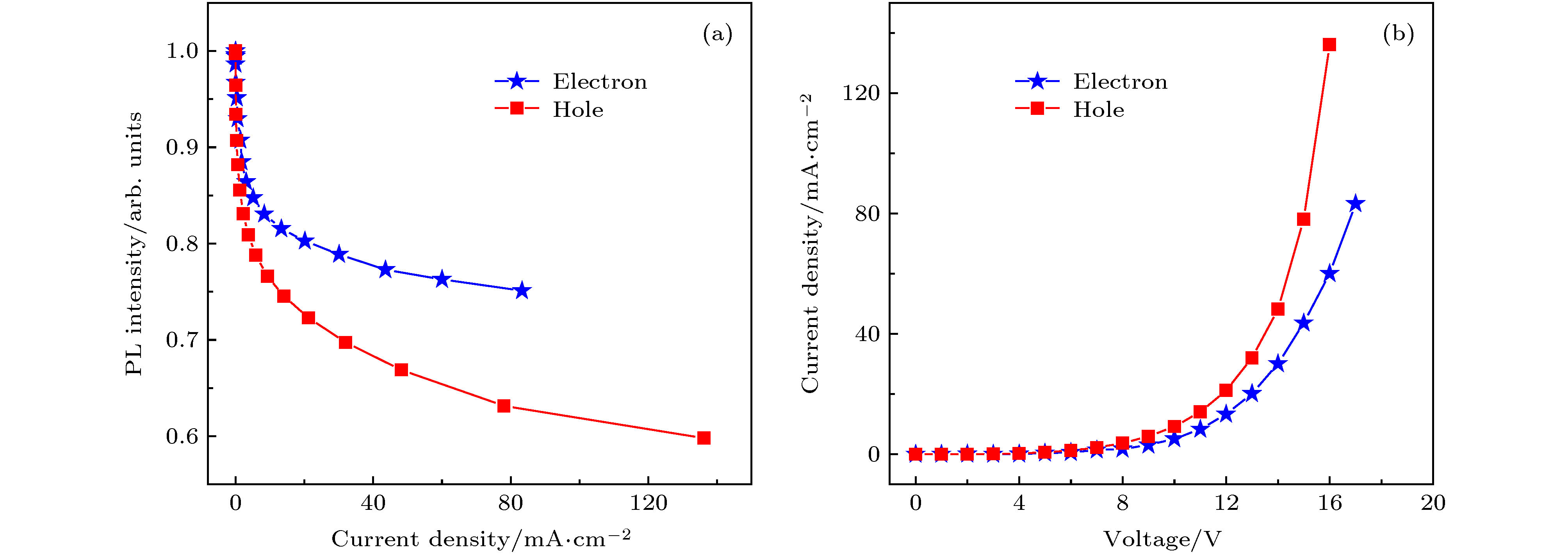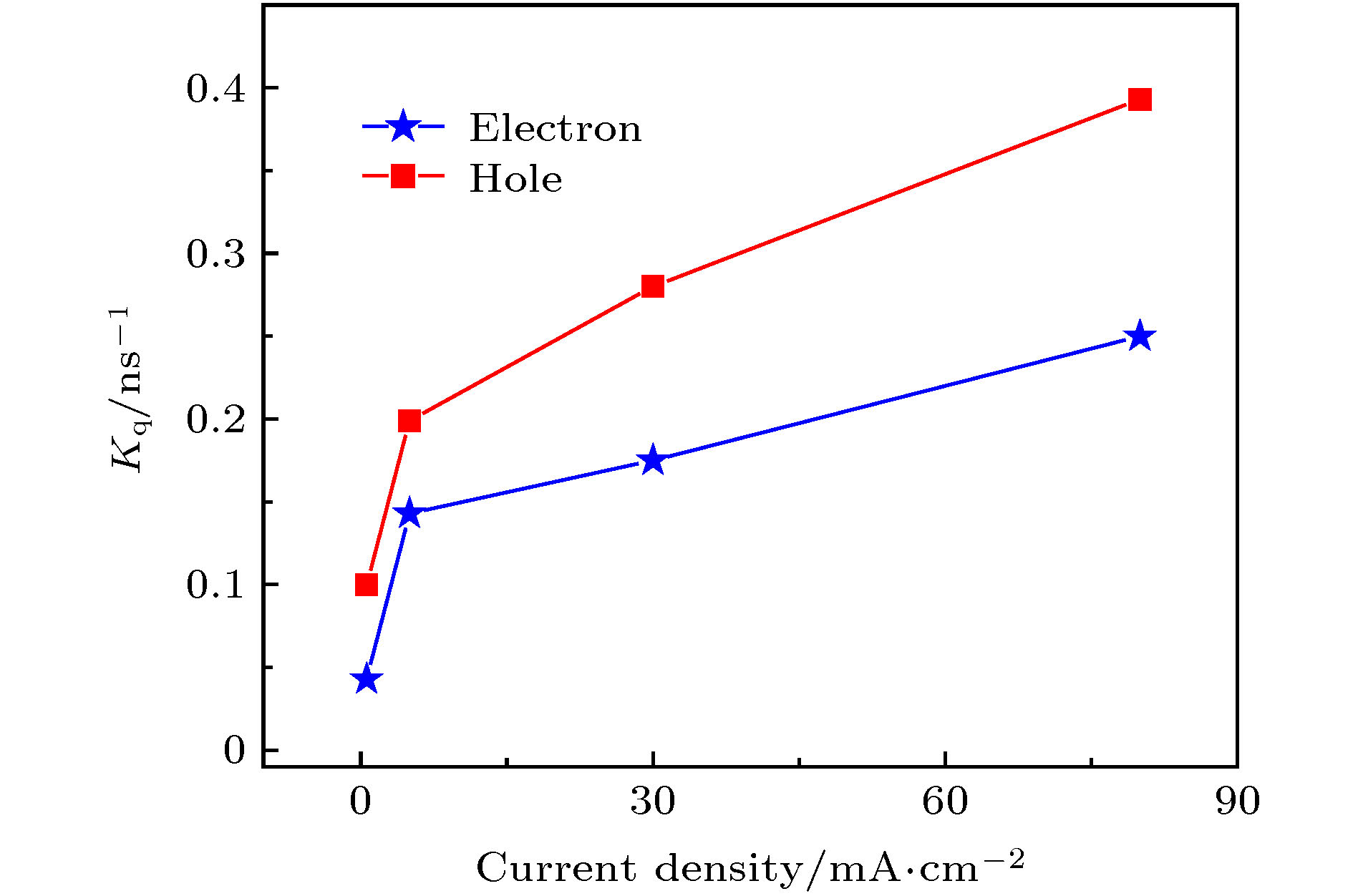-
OLEDs are popular as display technology nowadays, which have been widely used in commercial application. However, there are still some problems that blue light devices are not as efficient or stable as red and green light devices. Although the use of phosphorescent dyes can significantly improve the internal quantum efficiency, the high production cost and unstable performance limit the industrialization of phosphorescent OLEDs. In the development of OLEDs, the researchers found that OLEDs suffered from a decline in their efficiency at high brightness levels, a behavior known as “efficiency roll-off”. The efficiency roll-off is more pronounced in phosphorescent devices due to the longer lifetime of triplet exciton than singlet exciton, so that it has been widely investigated in recent years. Little is known, still, about fluorescent devices. Accordingly, unraveling the exciton loss mechanism in blue fluorescent OLEDs is particularly important, as it is a limiting factor for the improvement of efficiency. In this work, the efficiency roll-off in blue fluorescent OLEDs is investigated by observing the quenching of DPAVBI excitons. Firstly, the effects of electron current and hole current on photoluminescence(PL) behavior of unipolar devices are studied by steady-state and transient-state measurements, and we analyze PL spectrum and calculate the exciton quenching rate constant according to the transient PL decay curves to clarify the exciton quenching dynamics. The results show that the holes are much more efficient in quenching the excitons when the host is a hole transport material. This is different from the general understanding that exciton-polaron quenching effect with higher carrier mobility is weaker. Because the existence of bound charges produces additional charge density, and it is inferred that the exciton is mainly quenched by trapped charge rather than moving charge. We also exclude the effect of exciton–exciton annihilation and electric-field-induced dissociation on the efficiency degradation of the OLEDs. It is confirmed experimentally that exciton-polaron interaction is the dominant mechanism of the efficiency roll-off in fluorescent OLEDs. We then fabricate organic light-emitting diode devices with different doping concentrations to figure out the effect of doping concentration on exciton-polaron interaction, and obtain a blue fluorescence device with good comprehensive performance. We also summarize some feasible methods to optimize the efficiency of the OLEDs. In this paper, our findings about exciton-polaron interaction might provide a viable source for efficiency improvement by regulating charge trapping in light emitting layer.
[1] 汪津, 赵毅, 谢文法, 段羽, 陈平, 刘式墉 2011 物理学报 60 579
 Google Scholar
Google Scholar
Wang J, Zhao Y, Xie W F, Duan Y, Chen P, Liu S Y 2011 Acta Phys. Sin. 60 579
 Google Scholar
Google Scholar
[2] Song W, Lee J Y 2017 Org. Electron. 51 1
 Google Scholar
Google Scholar
[3] 崔荣朕, 唐艳茹, 马玉芹, 杨秀云, 耿丽华, 李云辉 2015 应用化学 32 855
 Google Scholar
Google Scholar
Cui R L, Tang Y R, Ma Y Q, Yang X Y, Gen L H, Li Y H 2015 Chin. J. Appl. Chem. 32 855
 Google Scholar
Google Scholar
[4] Xu Z, Tang B Z, Wang Y, Ma D G 2020 J. Mater. Chem. C 8 2614
 Google Scholar
Google Scholar
[5] Song D D, Zhao S L, Luo Y C, Aziz H 2010 Appl. Phys. Lett. 97 3
 Google Scholar
Google Scholar
[6] Luo Y C, Aziz H, Xu G, Popovic Z D 2007 Chem. Mater. 19 2288
 Google Scholar
Google Scholar
[7] Guo K, Li W, Zhang J, Zhang X, Wang X, Chen G, Xu T, Yang L, Zhu W, Wei B 2016 RSC Adv. 6 55626
 Google Scholar
Google Scholar
[8] Wang Q, Oswald I W H, Perez M R, Jia H, Gnade B E, Omary M A 2013 Adv. Funct. Mater. 23 5420
 Google Scholar
Google Scholar
[9] Reineke S, Walzer K, Leo K 2007 Phys. Rev. B 75 13
 Google Scholar
Google Scholar
[10] Baldo M A, Adachi C, Forrest S R 2000 Phys. Rev. B 62 10967
 Google Scholar
Google Scholar
[11] Giebink N C, Forrest S R 2008 Phys. Rev. B 77 9
 Google Scholar
Google Scholar
[12] Fukuda T, Okada T, Wei B, Ichikawa M, Taniguchi Y 2007 Appl. Phys. Lett. 90 3
 Google Scholar
Google Scholar
[13] 王利顺 2010 硕士学位论文 (保定: 河北大学)
Wang L S 2010 M. S. Thesis (Baoding: Hebei University) (in Chinese)
[14] Seo J A, Jeon S K, Lee J Y 2016 Org. Electron. 34 33
 Google Scholar
Google Scholar
[15] Baldo M A, Holmes R J, Forrest S R 2002 Phys. Rev. B 66 16
 Google Scholar
Google Scholar
[16] Murawski C, Leo K, Gather M C 2013 Adv. Mater. 25 6801
 Google Scholar
Google Scholar
[17] Song W, Kim T, Lee Y, Lee J Y 2017 Org. Electron. 43 82
 Google Scholar
Google Scholar
[18] Tan Y, Wang Z, Wei C, Liu Z, Bian Z, Huang C 2019 Org. Electron. 69 77
 Google Scholar
Google Scholar
[19] 廖立敏, 邓兵, 雷光东 2017 光谱学与光谱分析 37 636
 Google Scholar
Google Scholar
Liao L M, Deng B, Lei G D 2017 Spectrosc. Spect. Anal. 37 636
 Google Scholar
Google Scholar
[20] 林娜 2016 博士学位论文 (北京: 清华大学)
Lin N 2016 Ph. D. Dissertation (Beijing: Tsinghua University) (in Chinese)
[21] Patil V V, Lee K H, Lee J Y 2020 J. Mater. Chem. C 8 3051
 Google Scholar
Google Scholar
[22] Wu Z G, Zheng Y X, Zhou L, Wang Y, Pan Y 2017 Org. Electron. 42 141
 Google Scholar
Google Scholar
[23] Lee J H, Huang C L, Hsiao C H, Leung M K, Yang C C, Chao C C 2009 Appl. Phys. Lett. 94 3
 Google Scholar
Google Scholar
[24] Song W, Lee J Y 2017 Org. Electron. 49 152
 Google Scholar
Google Scholar
[25] Liu Z J, Zheng W Y, Wei P, Xu Z, Song D D, Qiao B, Zhao S L 2020 RSC Adv. 10 13215
 Google Scholar
Google Scholar
-
-
[1] 汪津, 赵毅, 谢文法, 段羽, 陈平, 刘式墉 2011 物理学报 60 579
 Google Scholar
Google Scholar
Wang J, Zhao Y, Xie W F, Duan Y, Chen P, Liu S Y 2011 Acta Phys. Sin. 60 579
 Google Scholar
Google Scholar
[2] Song W, Lee J Y 2017 Org. Electron. 51 1
 Google Scholar
Google Scholar
[3] 崔荣朕, 唐艳茹, 马玉芹, 杨秀云, 耿丽华, 李云辉 2015 应用化学 32 855
 Google Scholar
Google Scholar
Cui R L, Tang Y R, Ma Y Q, Yang X Y, Gen L H, Li Y H 2015 Chin. J. Appl. Chem. 32 855
 Google Scholar
Google Scholar
[4] Xu Z, Tang B Z, Wang Y, Ma D G 2020 J. Mater. Chem. C 8 2614
 Google Scholar
Google Scholar
[5] Song D D, Zhao S L, Luo Y C, Aziz H 2010 Appl. Phys. Lett. 97 3
 Google Scholar
Google Scholar
[6] Luo Y C, Aziz H, Xu G, Popovic Z D 2007 Chem. Mater. 19 2288
 Google Scholar
Google Scholar
[7] Guo K, Li W, Zhang J, Zhang X, Wang X, Chen G, Xu T, Yang L, Zhu W, Wei B 2016 RSC Adv. 6 55626
 Google Scholar
Google Scholar
[8] Wang Q, Oswald I W H, Perez M R, Jia H, Gnade B E, Omary M A 2013 Adv. Funct. Mater. 23 5420
 Google Scholar
Google Scholar
[9] Reineke S, Walzer K, Leo K 2007 Phys. Rev. B 75 13
 Google Scholar
Google Scholar
[10] Baldo M A, Adachi C, Forrest S R 2000 Phys. Rev. B 62 10967
 Google Scholar
Google Scholar
[11] Giebink N C, Forrest S R 2008 Phys. Rev. B 77 9
 Google Scholar
Google Scholar
[12] Fukuda T, Okada T, Wei B, Ichikawa M, Taniguchi Y 2007 Appl. Phys. Lett. 90 3
 Google Scholar
Google Scholar
[13] 王利顺 2010 硕士学位论文 (保定: 河北大学)
Wang L S 2010 M. S. Thesis (Baoding: Hebei University) (in Chinese)
[14] Seo J A, Jeon S K, Lee J Y 2016 Org. Electron. 34 33
 Google Scholar
Google Scholar
[15] Baldo M A, Holmes R J, Forrest S R 2002 Phys. Rev. B 66 16
 Google Scholar
Google Scholar
[16] Murawski C, Leo K, Gather M C 2013 Adv. Mater. 25 6801
 Google Scholar
Google Scholar
[17] Song W, Kim T, Lee Y, Lee J Y 2017 Org. Electron. 43 82
 Google Scholar
Google Scholar
[18] Tan Y, Wang Z, Wei C, Liu Z, Bian Z, Huang C 2019 Org. Electron. 69 77
 Google Scholar
Google Scholar
[19] 廖立敏, 邓兵, 雷光东 2017 光谱学与光谱分析 37 636
 Google Scholar
Google Scholar
Liao L M, Deng B, Lei G D 2017 Spectrosc. Spect. Anal. 37 636
 Google Scholar
Google Scholar
[20] 林娜 2016 博士学位论文 (北京: 清华大学)
Lin N 2016 Ph. D. Dissertation (Beijing: Tsinghua University) (in Chinese)
[21] Patil V V, Lee K H, Lee J Y 2020 J. Mater. Chem. C 8 3051
 Google Scholar
Google Scholar
[22] Wu Z G, Zheng Y X, Zhou L, Wang Y, Pan Y 2017 Org. Electron. 42 141
 Google Scholar
Google Scholar
[23] Lee J H, Huang C L, Hsiao C H, Leung M K, Yang C C, Chao C C 2009 Appl. Phys. Lett. 94 3
 Google Scholar
Google Scholar
[24] Song W, Lee J Y 2017 Org. Electron. 49 152
 Google Scholar
Google Scholar
[25] Liu Z J, Zheng W Y, Wei P, Xu Z, Song D D, Qiao B, Zhao S L 2020 RSC Adv. 10 13215
 Google Scholar
Google Scholar
Catalog
Metrics
- Abstract views: 12778
- PDF Downloads: 213
- Cited By: 0















 DownLoad:
DownLoad:






